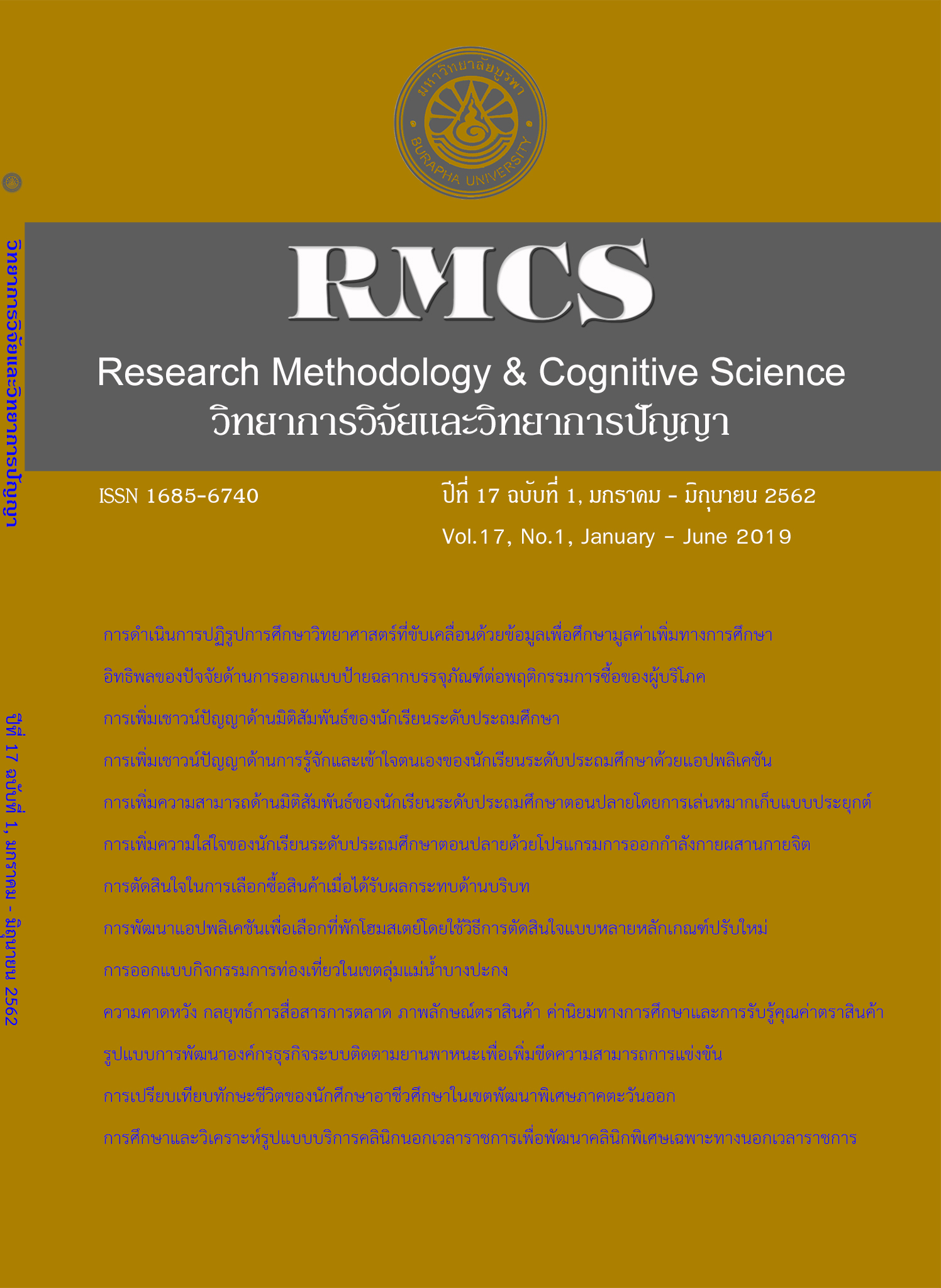การตัดสินใจในการเลือกซื้อสินค้าเมื่อได้รับผลกระทบด้านบริบท
Main Article Content
บทคัดย่อ
การวิจัยครั้งนี้มีวัตถุประสงค์เพื่อ 1) ศึกษาผลการตัดสินใจที่เกิดจากผลกระทบด้านบริบท 3 ด้าน ได้แก่ ผลกระทบด้านความคล้าย ผลกระทบด้านความดึงดูด และผลกระทบด้านความประนีประนอม เมื่ออยู่ในสถานการณ์การตัดสินใจภายใต้เวลาจำกัดและเวลาไม่จำกัด 2) ศึกษาลักษณะการกระจายของเวลาตอบสนองในการตัดสินใจที่ได้รับผลกระทบด้านบริบท เมื่ออยู่ในสถานการณ์การตัดสินใจภายใต้เวลาจำกัดและเวลาไม่จำกัด กลุ่มตัวอย่างเป็นทหารกองประจำการ สังกัดกรมการทหารสื่อสาร กองทัพบก กรุงเทพมหานคร ปีงบประมาณ 2558 จำนวน 60 คน เครื่องมือวิจัยเป็นแบบวัดค่าตัวแปรการตัดสินใจ ซึ่งพัฒนาขึ้นด้วย COGENT Toolbox บนโปรแกรม MATLAB ถูกออกแบบเพื่อการตรวจวัดความถี่สัมพัทธ์ของการเลือกตอบและเวลาตอบสนองที่ใช้แต่ละคำถาม โดยกำหนดคำถามในการตัดสินใจเพื่อเลือกซื้อโทรศัพท์มือถือจำนวน 52 ข้อ แบ่งเป็น คำถามเพื่อสร้างความคุ้นเคยในการเลือกตอบ จำนวน 4 ข้อ คำถามเพื่อเลือกซื้อโทรศัพท์มือถือ 1 ผลิตภัณฑ์จากทั้งหมด 2 ผลิตภัณฑ์ และจากทั้งหมด 3 ผลิตภัณฑ์ จำนวนอย่างละ 24 ข้อ รวมเป็น 48 ข้อ โดยแต่ละข้อ กำหนดคุณลักษณะของโทรศัพท์ ด้านราคาและด้านคุณภาพ
ผลการวิจัยพบว่า ภายใต้สถานการณ์การตัดสินใจที่เวลาไม่จำกัด และเวลาจำกัด ร้อยละ 25, 50 และ 75 ความน่าจะเป็นตัวเลือกมีความสอดคล้องกับความน่าจะเป็นตัวเลือกจากการศึกษาที่ผ่านมา โดยจากทั้งหมด 12 รูปแบบผลกระทบด้านบริบท มีความสอดคล้อง 10, 8, 8, และ 8 รูปแบบตามลำดับ และเวลาตอบสนองมีการกระจายแบบเอ็กซ์เกาเซียน (Ex-Gaussian) สอดคล้องกับจากการศึกษาที่ผ่านมา โดยมีค่า BIC เท่ากับ -352.983, -256.010, -239.712 และ -216.745 ตามลำดับ
Article Details
เอกสารอ้างอิง
Ashby, F. G., & Maddox, W. T. (1993). Relations between prototype, exemplar, and decision bound models of categorization. Journal of Mathematical Psychology, 37(3), 372-400
Ayre, C., & Scally, A. (2014). Critical values for Lawshe’s content validity ratio: revisiting the original methods of calculation. Measurement and Evaluation in Counseling and Development, 47(1), 79-86.
Bateman, I. J., Munro, A., & Poe, G. L. (2008). Decoy effects in choice experiments and contingent valuation: asymmetric dominance. Land Economics, 84(1), 115-127.
Burnham, T. A., Frels, J. K., & Mahajan, V. (2003). Consumer switching costs: A typology, antecedents, and consequences. Journal of the Academy of marketing Science, 31(2), 109-126.
Busemeyer, J. R., & Diederich, A. (2010). Cognitive Modeling. California: SAGE Publications Ltd.
Chuang, S., & Yen, H. (2007). The impact of a product’s country-of-origin on compromise and attraction effects. Marketing letters, 18(4), 279-291.
Diederich, A. (2003). MDFT account of decision making under time pressure. Psychonomic Bulletin & Review, 10(1), 157-166.
Fraser-Mackenzie, P., & Dror, I. (2009). Dynamic reasoning and time pressure: Transition from analytical operations to experiential responses. Theory Dec, 71(1), 211-225.
Huber, J., Payne, J. W., & Puto, C. (1982). Adding Asymmetrically Dominated Alternatives: Violations of Regularity and the Similarity Hypothesis. Journal of consumer research, 9(1), 90-98.
Kahneman, D., & Tversky, A. (2013). Prospect theory: An analysis of decision under risk. In Handbook of the fundamentals of financial decision making: Part I (pp. 99-127): World Scientific.
Lacouture, Y., & Cousineau, D. (2008). How to use MATLAB to fit the ex-Gaussian and other probability functions to a distribution of response times. Tutorials in Quantitative Methods for Psychology, 4(1), 35-45.
Lawshe, C. H. (1975). A quantitative approach to content validity. Personnel psychology, 28(4), 563-575.
Lewin, K. (1935). A dynamic theory of personality: Selected papers (DK Adams & KE Zener, Trans.). New York: McGraw.
Matzke, D. & Wagenmakers, E. J. (2009). Psychological interpretation of the ex-Gaussian and shifted Wald parameters: A diffusion model analysis. Psychonomic Bulletin & Review, 16(5), 798-817.
Noguchi, T. & Stewart, N. (2014). In attraction, compromise, and similarity effects, alternatives are repeatedly compared in pairs on single dimensions. Cognition, 132(1), 44-56.
Nosofsky, R. M. (1988). Exemplar-based accounts of relations between classification, recognition, and typicality. Journal of Experimental Psychology: learning, memory, and cognition, 14(4), 700.
Nosofsky, R. M. (1992). Similarity scaling and cognitive process models. Annual review of psychology, 43(1), 25-53.
Payne, J. W. (1976). Task complexity and contingent processing in decision making: An information search and protocol analysis. Organizational Behavior and Human Performance, 16(2), 366-387.
Payne, J. W., Bettman, J. R., & Johnson, E. J. (1988). Adaptive strategy selection in decision making. Journal of Experimental Psychology: learning, memory, and cognition, 14(3), 534.
Pettibone, J. C. (2012). Testing the effect of time pressure on asymmetric dominance and compromise decoys in choice. Judgment and Decision Making, 7(4), 513.
Roe, R. M., Busemeyer, J. R., & Townsend, J. T. (2001). Multialternative decision field theory: A dynamic connectionst model of decision making. Psychological review, 108(2), 370.
Sedikides, C., Ariely, D., & Olsen, N. (1999). Contextual and procedural determinants of partner selection: Of asymmetric dominance and prominence. Social Cognition, 17(2), 118-139.
Shugan, S. M. (1980). The cost of thinking. Journal of consumer research, 7(2), 99-111.
Simonson, I. (1989). Choice Based on Reasons: The Case of Attraction and Compromise Effects. Journal of consumer research, 16(2), 158-174.
Simon, H. A. (1957). Models of man; social and rational. New York: Wiley.
Townsend, J. T., & Busemeyer, J. R. (1989). Approach-avoidance: Return to dynamic decision behavior. In C. Izawa (Ed.), Current issues in cognitive processes: The Tulane Flowerree Symposium on Cognition (pp. 107-133). Hillsdale, NJ, US: Lawrence Erlbaum Associates, Inc.
Trueblood, J. S., Brown, S. D., Heathcote, A., & Busemeyer, J. R. (2013). Not just for consumers: Context effects are fundamental to decision making. Psychological Science, 24(6), 901-908.
Tversky, A. (1972). Elimination by aspects: A theory of choice. Psychological Review, 79(4), 281-299.
Wilson, F. R., Pan, W., & Schumsky, D. A. (2012). Recalculation of the critical values for Lawshe’s content validity ratio. Measurement and Evaluation in Counseling and Development, 45(3), 197-210.
Yang, S., & Lynn, M. (2014). More evidence challenging robustness and usefulness of the attraction effect. Journal of Marketing Research, 51(4), 508-513.

